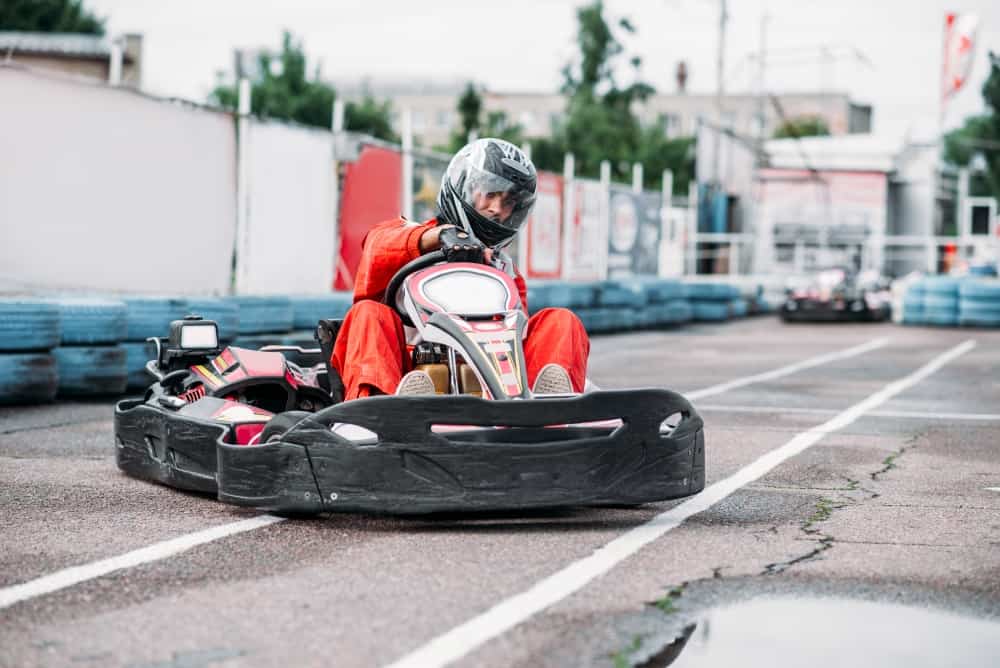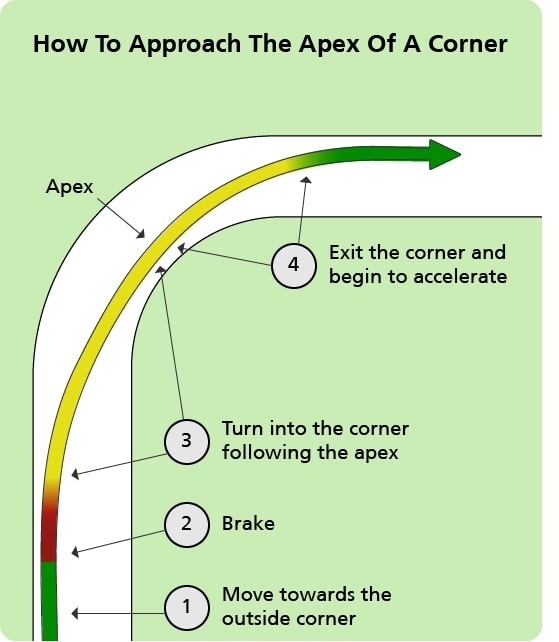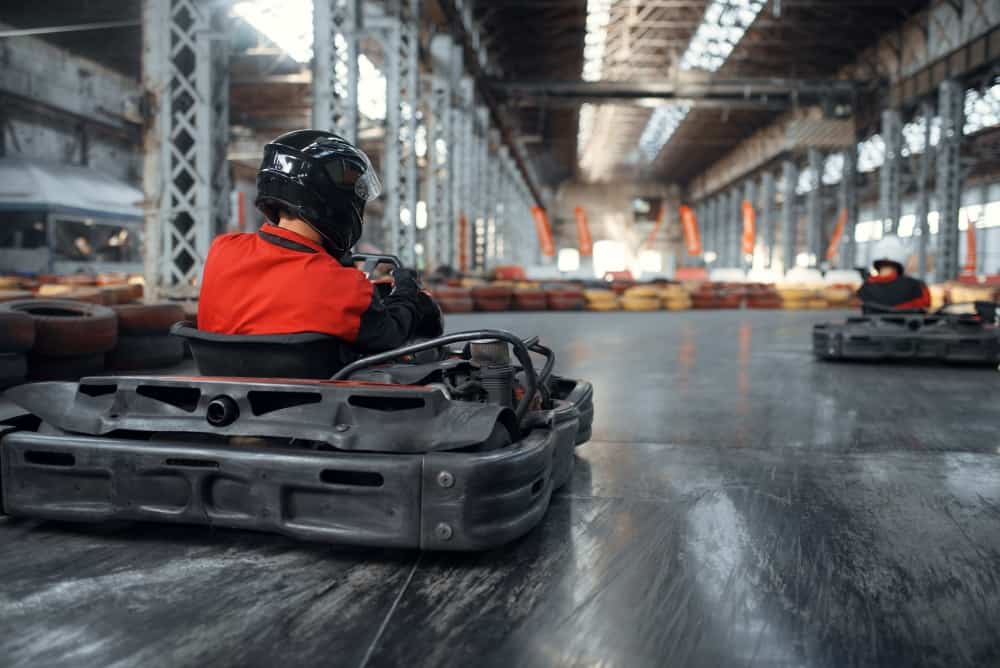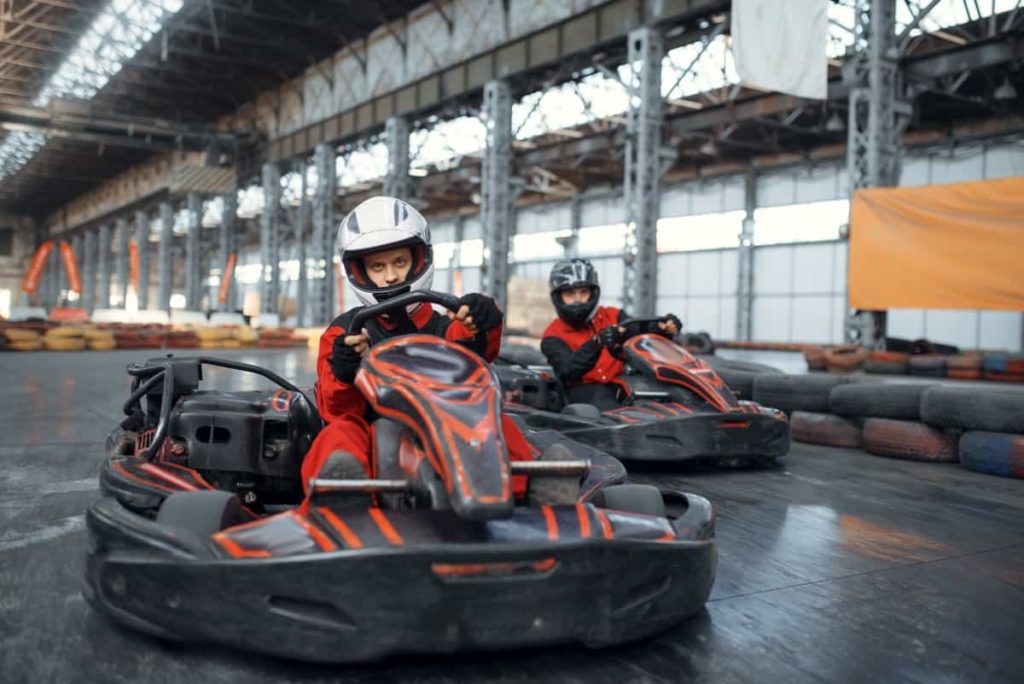But if you’ve never tried it before, the idea of intensely whizzing around a track at 60mph is understandably intimidating, and so the weeks before your first-ever go-kart session can be both equally exciting and anxiety-inducing.
This is especially the case if you’re the ultra-competitive type, as while you might have had plenty of dreams about spraying champagne on the podium, the nightmare of finishing dead last or being suitably embarrassed by your bad driving is just as likely.
Everybody wants to be the next Lewis Hamilton rather than the next Al Pease (Google him), but unfortunately, not many of us are graced with the natural prowess and instincts of an F1 driver.
So to save you slaloming into the barriers with every turn and being lapped like a lemon, we’ve put together this handy set of tips and tricks for go-kart beginners to follow.
We can’t promise you still won’t come last – buy by God, why not do it with style!?
Go-Karting Tips

Lay Off The Lean
When you’re behind the wheel of a go-kart for the first time, it’s easy to get carried away – with many rookie racers ridiculously swaying their bodies with every steer.
But while this is undoubtedly a fun and immersive way to drive, it’s also a pretty shocking technique, as leaning places all your weight onto one side of the kart and affects your control.
If you truly want to conquer corners, you’ll have to resist the temptation to fully lean into them, so try to always sit up straight and keep your weight evenly distributed.
Seat Set-Ups
Don’t be shy about making adjustments to your kart if it (literally) doesn’t sit right with you.
Your seating position needs to be as comfortable as possible so that you have no driving distractions and it’s even more crucial that your feet are able to reach the pedals!
Most karts should provide a lever for adjusting the seat height, so be sure to find that racer’s sweet spot before you put the pedal to the metal!
Learn The Line
A tricky lesson to implement, while you might not be able to find a great racing line first time out, it’s important you at least understand the concept if you don’t want to become a cropper on every corner.
The racing line basically alludes to the course you decide to take around the track – with those who find the ‘perfect line’ being able to maximise their speed through corners and beat out most of their competitors.
Finding the perfect line is about understanding a track as a whole – knowing where to come in aggressively and narrow or where to play it safe and keep wide, always looking to reduce the angle of corners and lessen lap times.

As a novice driver though, it’s unlikely you’d be able to look at a course and devise a great racing line before getting in the driver’s seat – so for beginners, it’s best to just understand the basic rules of following the line first.
To find a great racing line, it’s imperative you can follow these five steps when coming into a corner, as they will help you keep a tight angle and not lose speed.
POSITION YOURSELF
When running a race on two feet, most people like to hug the inside lane so that they can turn the corner faster.
However, when going at speed in a go-kart, hugging the inside lane is a bad idea, as you’ll give yourself nowhere near enough time to effectively turn the kart.
That’s why before every corner you should position yourself at a much wider starting point so that by the time you hit the apex of the corner, your kart is already aligned in the right direction.
This will help you reduce the angle, maintain speed and allow you to apply lots of acceleration when exiting corners.
BRAKING
Coming into a bend at full speed is a recipe for disaster, and you’ll likely not even manage to perform a full turn if you come in too hot and heavy.
Instead, you need to be smoothly breaking as you enter a corner, giving yourself time to find the perfect turning point and get your kart in the best position possible.
THE TURNING POINT
Naturally, this is where finding the perfect racing line is often won and lost, as the point at which you begin to turn is the definitive factor in how well you tackle the corner.
If you go too early, you’ll narrowly miss or clip the edge and come out of the corner facing too wide, meaning a lot of extra turning is required and you’ll most likely just collide with a barrier.
If you go too late, you won’t have effectively reduced the angle and while you’ll safely tackle the corner and come out of it facing straight ahead – you’ll be following a much slower racing line and leave yourself open to overtaking.
Finding the sweet spot is admittedly difficult, but a perfect turn should see you narrowly pass the apex and leave you facing straight ahead in a wide position, once completing the corner.
TIMING THE APEX
This apex refers to the narrowest point of the corner, and it’s where you’re aiming to just skip past to ensure the most reduced angle.
Many circuits feature curbs or spots of grass to mark the apex which can give you a good visual clue of the spot you need to make a beeline for. In general, fast corners have early apexes that need to be aimed for immediately, while slower or hairpin bends will become more visible after you’ve begun turning.
If you hit the apex spot precisely, you can begin going full throttle on your accelerator to power out of the corner and through the track.
EXITING
If it’s full track ahead, you’re free to go full speed ahead, but what makes following the racing line difficult is that there are so many surprises along the way.
As you exit a turn, you already need to be thinking about what’s coming next.
Where do you need to position yourself in order to complete the next corner or bend? Do you even have time to prepare? Should you have done it earlier?
Corners up ahead and chicanes can make exiting a little more tricky and this is what makes following a racing line so hard.
You’ll need to make calculated decisions at breakneck speed – and when you get it wrong, it’s often already too late.
Keeping Up The Pace
Go-karting isn’t like those daft driving arcade games at the bowling alley and so while keeping your foot stamped down on the accelerator might seem like the obvious tactic for maximising speed – it won’t get you very far.
Full throttle addicts find out very quickly through corner collisions that neglecting your breaks is a big no-no and so to master motor racing you must first learn how to time your bursts of pace.
To maintain speed on corners, the general rule is slow in – fast out.
This requires smooth braking on entering a corner, before switching to full-throttle acceleration as you exit through the apex.
Pedal Precision
So many rookies don’t want to give up on the accelerator and so will simultaneously press it along with the break when taking corners.
But this is real wacky races territory, as the pedals aren’t designed to be pressed down at the same time. Doing so leads to skidding, spin-outs and sometimes can just flat-out bust your kart.
Try and be more precise and smooth with the pedals for more deliberate and controlled driving.
The Overtaking Equation
If you want to win a go-kart race, you’d be pretty lucky to do so without overtaking anyone.
But just like on a real road, you should only ever overtake when it’s safe to do so and you’re confident you won’t be putting you or another kart in danger.

Given that most go-kart tracks provide drivers with exactly the same car, it’s unlikely you’re going to speed past someone on pace alone and so the majority of overtaking is done at the corners and bends.
Here are the most common overtaking spots:
Hairpin Bends: These big U-bends appear intimidating as they are such a large corner and so people often mistakenly brake early to prepare.
However the larger the bend, the slower it is and so the braking and turning points of a hairpin bend are actually much later. This makes them a great place to zoom past drivers who are preparing for the turn too early.
Chicanes: Usually coming in an S shape, chicanes are a group of fast alternating corners, with one immediately after the other.
Again, these are very intimidating and can cause drivers to really slow down to take the corners carefully and methodically.
However, provided you hit the apex of the first bend, following the racing line should feel fairly natural and there’s no need to break and turn as much as people do – making it ideal for the overtake.
Straights: Occasionally you can overtake someone on a straight, especially if you’ve just come out of a bend at lightspeed and they’re still recovering from a slow and laboured turn.
Stay Cool, Calm, Collected… And Have Fun!
If you’re a beginner, try and just enjoy the experience!
Yes, it’s great to win and leave pals in your dust, but you shouldn’t be putting any unneeded pressure on yourself!
While it’s easy to get caught up in the heat of a race or become frustrated if you don’t get the hang of it straight away, try not to let it affect you by keeping a relaxed grip on the wheel and keeping pedal actions smooth and deliberate as opposed to erratic.
It’s also wise to avoid becoming distracted or panicked by what’s going on around you, so don’t lose the plot if someone overtakes – just keep following your own racing line!


